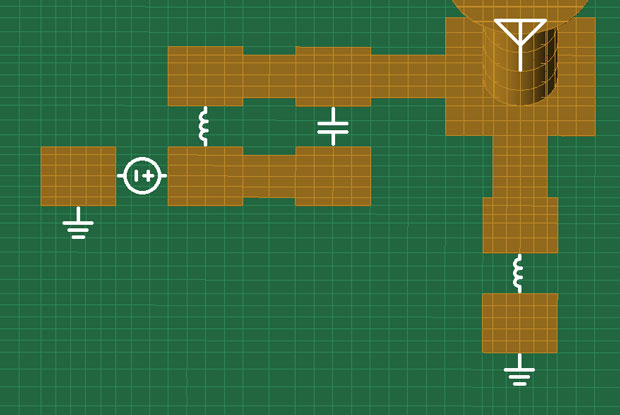Electromagnetic and Circuit Optimization Software Integrate

This screen capture shows the XFdtd Circuit Element Optimizer module, which optimizes lumped circuit elements directly in a physical matching circuit layout. Image courtesy of Remcom.
Design Exploration and Optimization News
Design Exploration and Optimization Resources


Latest News
October 7, 2015
Remcom recently announced the integration of its XFdtd 3D electromagnetic (EM) simulation software and Optenni Lab matching circuit optimization software from Optenni Ltd. The Optenni link, says Remcom, simplifies matching circuit optimization workflows by enabling XFdtd users to generate matching circuit schematics in one step, allowing them to move on to the full wave optimization phase quickly. The new integration lets users leverage XFdtd’s Circuit Element Optimizer module and Optenni Lab to complete the matching network design.
Now in release 7.5.1, XFdtd is a general-purpose, full wave 3D EM analysis software for modeling and optimizing device designs including implantable devices, mobile phones, wireless devices and waveguide antennas. XFdtd’s FDTD (finite difference time domain) analysis approach solves Maxwell’s equations in both the frequency and time domain, which enables the calculation of the EM field values to progress at discrete steps in time and gives broadband output from a single execution of the program. The FDTD approach, says the company, has excellent scaling performance as the problem size grows, making it fast and efficient.
Designers, such as antenna designers and RF (radio frequency) engineers, use the Circuit Element Optimizer add-on module for XFdtd to determine lumped element values based on radiation efficiency, system efficiency and S-parameters (scattering parameters). The module simplifies the antenna matching workflow since circuit elements remain in the electromagnetic layout structure during optimization, according to the company.
 Remcom says that the Optenni Lab link for its XFdtd 3D electromagnetic simulation software simplifies users’ workflow and generates their matching circuit schematic in one easy step. Shown here is a matching network in Optenni Lab. Image courtesy of Remcom.
Remcom says that the Optenni Lab link for its XFdtd 3D electromagnetic simulation software simplifies users’ workflow and generates their matching circuit schematic in one easy step. Shown here is a matching network in Optenni Lab. Image courtesy of Remcom.In describing the integration process, Remcom says that once users have laid out their topology choice on a PCB (printed circuit board) design, they use XFdtd’s Circuit Element Optimizer module to complete the matching network design process by determining the optimal component values. To do so, the Circuit Element Optimizer uses full-wave FDTD simulation, taking electromagnetic phenomena, such as coupling, into account.
The new XFdtd-Optenni Lab integration allows users to transfer XFdtd data to Optenni Lab directly. Optenni Lab, which provides fully automatic matching circuit generation and optimization routines, synthesizes and optimizes matching network topologies and component values based on the S-Parameter and efficiency results from the XFdtd simulation. It then returns a choice of optimized matching circuit topologies that will meet the design criteria. The XFdtd Circuit Element Optimizer then takes the antenna matching schematic into the electromagnetic simulation and optimizes the lumped circuit elements directly in the physical matching circuit layout.
Additional, features of the integration include the ability to analyze single and multi-port devices as well as the ability to select inductors, capacitors and tunable components. Users can also choose matching network layouts based on targets for S-Parameters or efficiency. Optimizations can be performed over multiple bands.
 This screen capture shows the XFdtd Circuit Element Optimizer module, which optimizes lumped circuit elements directly in a physical matching circuit layout. Image courtesy of Remcom.
This screen capture shows the XFdtd Circuit Element Optimizer module, which optimizes lumped circuit elements directly in a physical matching circuit layout. Image courtesy of Remcom.“Optenni is a very focused tool that makes it easy to match the circuit for best performance and allows the user to play with what-if scenarios,” says Rodney Korte, product manager for XFdtd, in a press statement. “We felt it was a logical step to add the Optenni link into XFdtd to simplify users’ workflow, generate their matching circuit schematic in one easy step, and move more quickly to the full wave optimization phase.”
For further details on XFdtd and the new integration with Optenni Lab, visit Remcom.
Check out a video on the XFdtd-Optenni Lab integration.
Learn more about the XFdtd Circuit Element Optimizer module.
For a quick overview of Optenni Lab, click here.
See why DE‘s editors selected the XFdtd integration with Optenni Lab as their Pick of the Week.
Sources: Press materials received from the company and additional information gleaned from the company’s website.
Subscribe to our FREE magazine, FREE email newsletters or both!
Latest News
About the Author
Anthony J. Lockwood is Digital Engineering’s founding editor. He is now retired. Contact him via [email protected].
Follow DE



